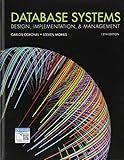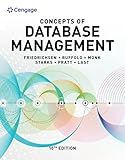Best Database Management Tools to Buy in December 2025

Database Systems: Design, Implementation, & Management



Database Systems: Design, Implementation, & Management



Database Systems: Design, Implementation, & Management



Concepts of Database Management (MindTap Course List)



Statistics: A Tool for Social Research and Data Analysis (MindTap Course List)



Bioinformatics for Beginners: Genes, Genomes, Molecular Evolution, Databases and Analytical Tools



Data Mining: Practical Machine Learning Tools and Techniques (Morgan Kaufmann Series in Data Management Systems)
- UNMATCHED INNOVATION: STAY AHEAD WITH OUR CUTTING-EDGE FEATURES!
- EXCLUSIVE LAUNCH PROMO: SAVE BIG ON YOUR FIRST PURCHASE TODAY!
- CUSTOMER SATISFACTION: PROVEN QUALITY THAT ENHANCES DAILY LIFE!



The Manga Guide to Databases (The Manga Guides)



Database Design for Mere Mortals: A Hands-On Guide to Relational Database Design


The buffer cache in an Oracle database is a key component of Oracle's memory architecture. It is designed to enhance database performance by reducing disk I/O operations.
When data is read from disk, it is stored in memory blocks, which are then cached in the buffer cache. The buffer cache is a section of the Oracle System Global Area (SGA) that holds a subset of data blocks from the database files.
When a user requests data from the database, Oracle first checks if the required data already exists in the buffer cache. If it does, Oracle retrieves the data from memory without needing to access the disk, resulting in faster access times. This process is known as a buffer hit.
However, if the requested data is not present in the buffer cache, it results in a buffer miss. In such cases, Oracle retrieves the required data from the disk and brings it into the buffer cache. It also replaces less frequently used data blocks in the cache to make space for the newly requested data.
The buffer cache works on the principle of the least recently used (LRU) algorithm. This means that if a data block is accessed frequently, it remains in the cache, while less frequently accessed blocks are evicted to make way for more important or frequently used blocks.
The size of the buffer cache is configurable and depends on various factors such as available memory, database workload, and system resources. Ideally, a larger buffer cache can hold more data blocks, leading to higher cache hit ratios and improved performance.
It is important to note that the buffer cache is shared among multiple user sessions. Thus, if one user modifies a data block in the cache, it becomes dirty. Oracle ensures that the changes are written back to the disk, allowing other users to see the updated data when accessing the block.
In summary, the buffer cache in an Oracle database stores frequently accessed data blocks in memory to reduce disk I/O operations and improve performance. It operates on the LRU algorithm and dynamically manages the cache based on data access patterns.
How does the buffer cache impact database buffer hit ratios?
The buffer cache is a region of physical memory in a database system that is used to hold copies of data blocks from disk. The purpose of the buffer cache is to reduce the frequency of disk reads, which are significantly slower than memory access.
The buffer cache can have a significant impact on database buffer hit ratios in the following ways:
- Improved performance: By caching data blocks in memory, the buffer cache reduces the number of disk reads required to satisfy database queries. This leads to improved performance as the database can retrieve data more quickly from memory instead of waiting for disk I/O. As a result, the buffer hit ratio is likely to increase.
- Increased buffer hit ratio: The buffer hit ratio indicates the percentage of data requests that are satisfied from the buffer cache compared to the total number of data requests. When the buffer cache is large enough to hold a significant portion of frequently accessed data, the buffer hit ratio typically increases. This means that a greater proportion of data requests can be satisfied from the buffer cache, resulting in fewer disk reads and improved performance.
- Reduced disk I/O: When the buffer cache is effectively utilized, the number of disk I/O operations is reduced. As a result, the system experiences less I/O contention and better overall performance. This reduction in disk I/O can lead to an increase in the buffer hit ratio, as more data requests can be satisfied from the buffer cache.
- Efficient memory utilization: The buffer cache stores frequently accessed data blocks in memory, allowing for efficient utilization of available memory resources. By ensuring that frequently accessed data is readily available in memory, the buffer cache helps to optimize memory usage and improve the buffer hit ratio.
In summary, the buffer cache plays a crucial role in improving database buffer hit ratios by reducing the need for disk reads, increasing the availability of data in memory, and optimizing memory utilization. This leads to improved performance and reduced I/O contention.
What is the role of the buffer cache in database caching?
The buffer cache plays a crucial role in database caching by serving as a temporary storage area for frequently accessed data pages or blocks. It acts as an intermediary between the database and the disk storage system, mitigating the performance gap between the fast processing speed of the CPU and the comparatively slower speed of disk I/O operations.
Here are the main roles of the buffer cache in database caching:
- Data retrieval optimization: When a database receives a request for data, the buffer cache first checks if the requested data is already present in the cache. If it is, the data is fetched from the cache instead of accessing the disk, significantly reducing the latency and improving database response time.
- Read-ahead and write-behind operations: The buffer cache takes advantage of the principle of locality, whereby data accessed once is likely to be accessed again. When a data block is read from the disk into the cache, the buffer manager may also fetch adjacent blocks to increase the likelihood of future cache hits. Similarly, when data is modified, the buffer manager may delay writing the changes back to the disk, optimizing disk I/O by performing write-behind operations.
- Locking and consistency management: The buffer cache helps enforce database consistency by implementing locking mechanisms. When multiple concurrent users or transactions access the same data, the buffer cache ensures that only one user can update the data while others must wait, preventing data inconsistencies due to concurrent modifications.
- Caching efficiency: The buffer cache employs various caching algorithms and replacement policies (such as LRU - Least Recently Used) to optimize cache capacity usage and to ensure that the most frequently accessed data remains in cache, while infrequently used data is evicted to make space for new data.
Overall, the buffer cache in database caching acts as a vital component in enhancing database performance by reducing disk I/O, improving response time, and managing data consistency.
What is the purpose of the buffer cache in an Oracle database?
The buffer cache in an Oracle database is a portion of memory where data blocks from data files are stored after being read from disk. The primary purpose of the buffer cache is to improve the performance of the database by reducing the number of physical disk reads required to access frequently accessed data.
When data blocks are read from disk into the buffer cache, subsequent read requests for the same data can be satisfied from the buffer cache, which is much faster than retrieving data from disk. This helps to reduce the overall I/O operations and improves the response time of the database.
The buffer cache also plays a crucial role in reducing contention for data blocks among concurrent transactions. It implements a multi-versioning mechanism, known as Read Consistency, to allow multiple transactions to access the same data simultaneously without conflicting with each other. Each transaction can access a consistent snapshot of the data in the buffer cache, which is essential for maintaining data integrity and isolation.
Additionally, the buffer cache acts as a staging area for modifications made to the database. When data blocks need to be updated, the changes are made in the buffer cache first, and then eventually written back to the data files during regular or checkpointed writes. This helps to optimize the disk writes and minimize the impact of I/O on the database performance.
In summary, the buffer cache in an Oracle database plays a vital role in enhancing the performance, scalability, and concurrency of the database by reducing disk I/O, providing read consistency, and optimizing disk writes.
What types of data are stored in the buffer cache?
The buffer cache is a portion of memory in a computer system that is used to store recently accessed data from a secondary storage device, such as a hard disk drive. The data stored in the buffer cache includes:
- File data: This includes the contents of recently accessed files, including documents, images, videos, audio files, etc.
- Metadata: The buffer cache stores metadata associated with files, such as file attributes (size, permissions, timestamps), file system information, and directory structures.
- Database records: In the case of database systems, the buffer cache holds recently accessed data blocks or pages from database tables, indexes, and other data structures.
- Operating system structures: The buffer cache also stores certain operating system structures, like file system control blocks, inode tables, and other data related to the file system management.
- Network data: In some cases, the buffer cache can be used to store network packets or data being transferred over the network to improve the efficiency of data transmission.
- System-specific data: The buffer cache may also contain system-specific data, such as kernel data structures or device driver data, depending on the particular operating system.
Overall, the buffer cache is designed to hold frequently accessed data to reduce reliance on slower secondary storage devices, thereby improving the system's overall performance.
How does the buffer cache improve database query performance?
The buffer cache is a component of the database management system that stores frequently accessed data pages in memory. This improves database query performance in the following ways:
- Reduced disk access: By caching frequently accessed data pages in memory, the buffer cache reduces the need to fetch data from disk repeatedly. As a result, queries can retrieve data more quickly as disk read operations are slower than memory access.
- Reduced I/O operations: Accessing data from memory in the buffer cache eliminates the need to perform disk I/O operations, which take significant time. This reduces the overall I/O load on the storage system and improves query response times.
- Improved data availability: The buffer cache holds a copy of frequently accessed data pages, ensuring that they are readily available to satisfy subsequent query requests. This reduces the likelihood of waiting for data to be fetched from disk, resulting in faster query execution.
- Enhanced concurrency: The buffer cache allows multiple queries to access and modify data simultaneously without conflicting with each other. This is because the buffer cache maintains data consistency and isolation among concurrent transactions, enabling efficient and parallel query execution.
- Optimized system resources: By keeping frequently used data in memory, the buffer cache helps optimize the utilization of system resources. This is because memory access is significantly faster than disk access, allowing the database system to utilize CPU and other resources more efficiently, leading to improved query performance.
Overall, the buffer cache acts as a performance-enhancing layer between the disk storage and the query execution engine by reducing disk I/O, improving data availability, enabling concurrent access, and optimizing system resources, resulting in faster database query performance.
How does the buffer cache handle index blocks in Oracle?
In Oracle, the buffer cache is a memory area used to store frequently accessed data blocks from the database. When it comes to index blocks, the buffer cache works in a similar way as it does for data blocks, but with some additional considerations due to the nature of index structures.
- Block Fetching: When a query needs to search for data using an index, Oracle checks if the required index blocks are already in the buffer cache. If they are present, the blocks are used directly. If not, Oracle fetches the necessary index blocks from the disk into the buffer cache.
- LRU Algorithm: The buffer cache manages its space using a Least Recently Used (LRU) algorithm, where recently accessed blocks are kept in the cache while older and less frequently accessed blocks are evicted to make room for new ones. This applies to both data blocks and index blocks.
- Block Pinning: Index blocks may be "pinned" in the buffer cache. This means that they are kept in memory and not evicted via the LRU algorithm. Pinning is commonly used for frequently accessed index blocks to prevent excessive disk I/O and improve performance.
- Buffer Cache Size and Configuration: Oracle allows the configuration of the buffer cache size, which determines the amount of memory allocated for caching both data and index blocks. Properly sizing the buffer cache is crucial for ensuring optimal performance, as it affects the availability of index blocks in memory.
- Block Reuse: Oracle tries to reuse index blocks already present in the buffer cache to avoid unnecessary disk I/O. If an index block becomes invalid or no longer matching the query patterns, it can be restructured and reused before being replaced by new blocks fetched from disk.
Overall, the buffer cache handles index blocks by storing them in memory, using the LRU algorithm to optimize space utilization, and pinning frequently accessed index blocks to improve query performance.
